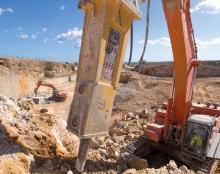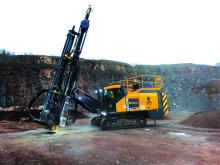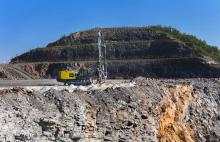
Safety and environmental requirements mean that quarry operators are turning to drill rigs and breakers as an alternative to explosives. Liam McLoughlin and Partha Pratim Basistha report
In a quarry in the southern Italian region of Apulia, an
The quarry was recently found to have good potential for producing the crushed stone that is used for railway track ballast. However, the quarry’s proximity to a provincial road, and the need to reduce the quantity of dust produced due to intense agricultural activity taking place around the quarry, precluded drilling and blasting and the use of explosives.
This prompted CO.MA to contract out the work to D’Oria Giuseppe e C, a company which has experience in the roadworks and concrete sector.
To handle the difficult task of quarrying stone material of hardness and unconfined compressive strength, D’Oria purchased an Indeco HP 18000 FS and a
D’Oria CEO Giuseppe Massari said quarrying the railway ballast had been a challenge. “We had to equip ourselves very specifically for this activity - first with a breaker such as the HP 18000 FS, the only one currently on the market with such size and power. The equipment assures the targeted rate of production, approximately 700-800 m3 of material quarried in an eight-hour shift, without failing to deliver excellent performance and reliability.”
He added that the choice of the HP 18000 was extremely important as it helped his team to solve the most important problem - production of material which is very hard and not fractured.
The Indeco HP 18000 FS is designed for special quarrying requirements where large-scale production is demanded. Indeco says it is having success in markets where drilling and blasting has seen a gradual decrease.
Four HP18000 breakers are also being used in India at the Chittorgarh limestone quarry in the state of Rajasthan. Indeco says the hardness of the material at the quarry and the high production output required are again spotlighting the advantages of the HP18000.
The quarry is managed by the cement production division of Birla Corporation, and its limestone supplies the Chanderiya cement factory, also owned by Birla Corporation, which is located 7km from the quarry. Birla Corporation is part of MP Birla Group, a multinational conglomerate with over 120,000 employees. With its seven plants, of which Chanderiya is one of the most important, Birla Corporation has a production potential of over 6.5 million tonnes of cement per year.
The Chittorgarh quarry contains enormous quantities of Nimbahera limestone, part of the Vindhyan Supergroup, one of the thickest sedimentary marine deposits of the Precambrian era to be found in India.
Until eight years ago the quarry, which has reserves lasting over 20 years, was mined by drilling and blasting. However, in 2011 the Rajasthan High Court ruled that the technique could no longer be employed as it risked damage to the nearby Chittorgarh Fort, a national monument dating back to the 14th century.
The mandatory switch from explosives to mechanical systems posed a challenge from a number of perspectives, according to V K Hamirwasia, the president of the cement factory: “The decision of the Rajasthan High Court created the conditions for a change in the way we mine the quarry, as well as production methods and logistics to a certain extent. Our investments have enabled us to guarantee the maximum output achievable using mechanical systems, but because we’ve had to increase the quantity of material, soon we’ll also have to increase the number of machines and equipment in our fleet too.”
Currently, 16 excavators (Hitachi 1200,
Quarry manager M K Ahmed says: “The Indeco breakers have proved very productive and reliable, especially when we consider that they’re used on a rotation basis over three shifts in a very heavy application. By now they have racked up a high number of hours in weather conditions that sometimes see temperatures of over 45 degrees.”
Global drill rigs and automation solution supplier
Traditional surface drilling requires a person to physically be in the cabin while operating the drill rig. Alternatively, the operator can be in the vicinity of the rig with a radio remote control.
Epiroc says that the SmartROC D65 drill rig is unique in being able to drill an entire pattern autonomously. The operator can be in an office away from the work site. Given that there is an internet connection, this office could potentially be located on the other side of the globe.
When the perimeter of autonomous operations, also known as the geofence, has been set up the SmartROC D65 is ready to operate. Within this area it can carry out the required operations needed to drill not just one hole autonomously, but a complete drill pattern. Epiroc says this means that the drill rig can tram to and position the feed foot correctly at the collaring point. It then drills the hole to the desired depth and will also handle rod change during the drill cycle. When the hole is drilled and the rods are retrieved, the rig moves on to the next hole until the entire drill pattern is completed.
This removes the operator from potentially hazardous benches in a mine or a quarry and will also let them carry out other tasks while the rig is drilling. Other benefits are increased productivity and better hole quality. When the SmartROC D65 is used for autonomous drilling, Epiroc says it will put more holes in the ground per shift - in part because automating the drilling process results in continuous operations without breaks and with less wear on drilling tools.
Most autonomous operations still need human monitoring, and this paves the way for a new generation of drill rig operators. Annie Levasseur is one of the first operators at the Hollinger mine to work with the autonomous SmartROC D65. She has been operating surface drill rigs the traditional way for many years and is now embracing the new technology.
“After our morning brief, instead of spending 30 minutes going by truck to the drill rig down in the pit, I just go to the office upstairs and start it up,” she said. “I’ll check the drill rig status, load the drill pattern and I’ll be up and drilling in a matter of minutes.”
South Africa-based construction, quarrying and mining equipment distributor ELB Equipment recently became the launch client for what is claimed to be one of the blasting and mining world’s most eagerly anticipated drills in recent times.
The new Furukawa DCR22 is a collaboration between a South African copper mine, distributor ELB Equipment and Furukawa, the manufacturer, which led to the development of a claimed world-beating, rugged and fast, new down-the-hole drill rig that is specially designed for tough, hard rock conditions.
According to Jimmy Linton, ELB Equipment product manager for Furukawa, due to the massive strides made and success of the developments of this drill, Furukawa has actually adopted the new machine and launched it globally for countries where hard rock and tough operating conditions occur.
“The copper mine provided its requirements to us and we worked with Furukawa to begin developments,” he said. “It actually took input from all quarters in terms of production requirements from engineers, operations personnel and operators to develop a machine that meets real-world requirements for production, safety, reliability and long-term durability.”
Germany’s current boom in mainstream construction is leading to high demand for natural stone grains. To meet this demand,
A pre-production model of the Ranger DX900i was presented at the Sandvik stand at
New and powerful RD920 series rock drills with outputs from 21 to 27 kW are available for the drill rig. The drill rig is equipped with Sandvik GT60 drill steel for straight holes in diameters from 92mm to 127mm. The rig is powered by a fuel-efficient 210 kW engine.
“What is special about this powerful type of drill rig is that even difficult, narrow and very uneven drilling fields can be drilled, which is not possible to the same extent with any other rig,” says company owner Klaus Berge.
Berge’s personnel were trained on a newly delivered Ranger DX900i in September 2018 at Hartsteinwerke Schicker OHG’s Diabas quarry in Kupferberg. The company currently operates four quarries in northern Bavaria – in Bad Berneck, Kupferberg, Stadtsteinach and Rugendorf.
Berge says construction of the new Ranger DX900i is different from its predecessor and is noticeably more stable. “It has also been confirmed that the new rock drill is stronger and, accordingly, strikes perfectly,” he adds. “For that reason, and also because more flushing air is available, it is more economical to drill.”
A Sandvik Ranger DX 800 top hammer surface drill is helping the Holcim Ambuja Cement plant in India to attain higher levels of efficiency for primary rock breaking.
Indian cement producers are heavily focused on increasing production output to meet growing demand amidst very high levels of competition in the industry. However, in conjunction with ramping up production capacities, producers are seeking to increase profitability by both cutting costs at the back-end plant level in the operation of grinding, processing and conveying equipment and by increasing the automation of process control.
A major area where measures to cut operational cost are visible is in primary breaking of limestone rocks through the deployment of advanced technologies.
To achieve this objective, Holcim Ambuja Cements acquired a Sandvik Ranger DX 800 top hammer hydraulic surface drill two years ago for drilling 115m diameter holes at its site in Bhatapara at Chhattisgarh, Central India. According to Holcim Ambuja officials, one of the main reasons for buying the drill is its features that deliver higher levels of productivity such as the 180-degree swivelling cabin of the machine. This allows it to drill 3-4 holes at a time, and the holes can be done between 34-36 metres/hr. The single operator machine comes with a self-contained dust collector.
The other main consideration for Holcim Ambuja when buying the Sandvik drill was its high levels of fuel efficiency. Earlier the plant was using a surface drill with direct-to-hole technology. The Ranger DX 800 undertakes drilling on the surface outside the hole at very high pressure based on a hydraulic mechanism. This is because oil is a more efficient medium than compressed air and can support an efficient hydraulic system, enabling it to drill holes at high pressure. This in turn contributes towards reduced fuel consumption.
Holcim Ambuja says that the Ranger DX 800 drills 36 metres per hour at 24 litres/hr, resulting in increased savings. This is compared with the previously used direct-to-hole drill which used to drill 30 metres/ hr at 45 litres/hr of fuel consumption without any breakdown. The company is considering the acquisition of a further Ranger DX 800.








